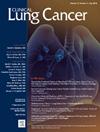Brief Report: Phase II Clinical Trial of Atezolizumab in Advanced Nonsmall Cell Lung Cancer Patients Previously Treated With PD-1-Directed Therapy
IF 3.3
3区 医学
Q2 ONCOLOGY
引用次数: 0
Abstract
- •There are limited prospective data evaluating the sequencing of anti-PD-L1 therapy after prior anti-PD-1 therapy in advanced NSCLC.
- •In patients with prior progression of immune checkpoint inhibition (ICI), primary resistance is defined as progressive or stable disease lasting less than 6 months after at least 2 cycles of ICI therapy, and secondary resistance is defined as an initial benefit of at least 6 months of ICI followed by progressive disease.
- •In the current study, atezolizumab was associated with a response rate of 11.8% amongst patients with prior progression on nivolumab and pembrolizumab, 0% amongst patients with prior stable disease on nivolumab or pembrolizumab and 12.5% amongst patients with prior partial or complete response to nivolumab or pembrolizumab.
- •Based on the data in the current study, a response rate of 10% may be considered the baseline activity of ongoing checkpoint inhibition in the immunotherapy experienced NSCLC population.
简要报告:曾接受 PD-1 导向疗法治疗的晚期非小细胞肺癌患者的 Atezolizumab II 期临床试验。
•评估晚期非小细胞肺癌患者既往抗pd -1治疗后抗pd - l1治疗序列的前瞻性数据有限。•在先前有免疫检查点抑制(ICI)进展的患者中,原发性耐药被定义为在至少2个周期的ICI治疗后持续不到6个月的进展性或稳定性疾病,继发性耐药被定义为在ICI治疗后至少6个月的初始获益,随后疾病进展。•在目前的研究中,atezolizumab与既往纳武单抗和派姆单抗进展的患者的缓解率相关,在既往纳武单抗或派姆单抗稳定的患者中为0%,在既往纳武单抗或派姆单抗部分或完全缓解的患者中为12.5%。•根据目前研究的数据,在接受免疫治疗的非小细胞肺癌人群中,10%的应答率可以被认为是正在进行的检查点抑制的基线活性。
本文章由计算机程序翻译,如有差异,请以英文原文为准。
求助全文
约1分钟内获得全文
求助全文
来源期刊

Clinical lung cancer
医学-肿瘤学
CiteScore
7.00
自引率
2.80%
发文量
159
审稿时长
24 days
期刊介绍:
Clinical Lung Cancer is a peer-reviewed bimonthly journal that publishes original articles describing various aspects of clinical and translational research of lung cancer. Clinical Lung Cancer is devoted to articles on detection, diagnosis, prevention, and treatment of lung cancer. The main emphasis is on recent scientific developments in all areas related to lung cancer. Specific areas of interest include clinical research and mechanistic approaches; drug sensitivity and resistance; gene and antisense therapy; pathology, markers, and prognostic indicators; chemoprevention strategies; multimodality therapy; and integration of various approaches.
 求助内容:
求助内容: 应助结果提醒方式:
应助结果提醒方式:


